The Times of India published a story on how the Indian Government is finally acknowledging the sacrifice of more than a million Indians who fought on the front lines of World War I. The Great War as it is known, was the first War in history to be globally fought on land, air, water and underwater.
Ever since Independence in 1947, the Indian Government has maintained a mysterious silence and turned a blind eye to India's contribution to the World Wars. It was as though there was an official edict, to cover up any memory of Indian soldiers who died fighting in the world wars because they were part of the British India Army. The only recognized World War I memorial in India is the India Gate. This however is now known more for the Amar Jawan Jyoti (The flame of the immortal warrior), which marks the Unknown Soldier's Tomb.
Almost every other country has taken pride in remembering and honouring their men who fell on the battle fields. Books, movies and pictures have immortalized these men in other countries, however their own home country refused to know them. Even Pakistan and Bangladesh have an equal right and moral duty to honour these men, as surely the 129th Baluchis company were from Baluchistan which is present day Pakistan or the Bengal Lancers who were from present day Bangladesh or the Indian state of West Bengal.
However Sonia Gandhi, the leader of the United Progressive Alliance which forms the Indian Government, visited a monument in honour of Indian Soldiers at Ieper, Belgium yesterday. It laid the ghosts of indifference to rest and the souls of thousands whose graves lie forgotten, scattered across distant lands and battlefields of old. It is a move in the right direction by India, in accepting history and acknowledging the contribution of these soldiers in the "Great War."
Ever since Independence in 1947, the Indian Government has maintained a mysterious silence and turned a blind eye to India's contribution to the World Wars. It was as though there was an official edict, to cover up any memory of Indian soldiers who died fighting in the world wars because they were part of the British India Army. The only recognized World War I memorial in India is the India Gate. This however is now known more for the Amar Jawan Jyoti (The flame of the immortal warrior), which marks the Unknown Soldier's Tomb.
Almost every other country has taken pride in remembering and honouring their men who fell on the battle fields. Books, movies and pictures have immortalized these men in other countries, however their own home country refused to know them. Even Pakistan and Bangladesh have an equal right and moral duty to honour these men, as surely the 129th Baluchis company were from Baluchistan which is present day Pakistan or the Bengal Lancers who were from present day Bangladesh or the Indian state of West Bengal.
However Sonia Gandhi, the leader of the United Progressive Alliance which forms the Indian Government, visited a monument in honour of Indian Soldiers at Ieper, Belgium yesterday. It laid the ghosts of indifference to rest and the souls of thousands whose graves lie forgotten, scattered across distant lands and battlefields of old. It is a move in the right direction by India, in accepting history and acknowledging the contribution of these soldiers in the "Great War."
Late on Friday night, Gandhi wrote a simple message in the Book of Honour of the Last Post Association, which has marked with haunting bugle call the soldiers' ultimate sacrifice at eight o'clock every night for 80 years.
Gandhi wrote, quoting the 19th-century American poet Emily Dickinson: "My being here to pay homage to the brave Indian soldiers who laid down their lives in the prime of their youth and so far away from their beloved motherland reminds me of the poet's line, 'It feels a shame to be alive when men so brave are dead, one envies the distinguished dust, permitted such a head'. I salute their memory".
“Remembering the past gives power to the present”
In World War I the Indian Army saw extensive service including: Western Front (Europe), Battle of Gallipoli, Sinai and Palestine Campaign, Mesopotamian Campaign, Siege of Kut, East Africa, including the Battle of Tanga.
About 43,000 Indian soldiers were killed and 65,000 wounded during World War I. Also serving in World War I were so-called "Imperial Service troops," provided by the semi-autonomous Princely States. About 21,000 of these were raised in Word War I, mainly consisting of Sikhs of Punjab and Rajputs from Rajputana (such as the Bikaner Camel Corps and Jodhpur Lances). These forces played a prominent part in the Palestine Campaign.
The Indian Army however has poignantly kept an entire section of the Indian Army War Museum in the Red Fort, Delhi as a tribute to their men and history. Here are some of the artifacts on display taken on my last visit. (Apologies for the poor image quality)
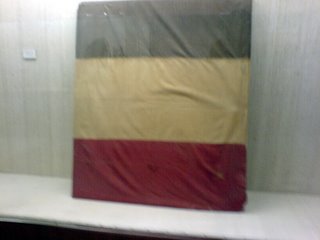
A German Flag captured by Indian Soldiers
from surrendering German troops in World War I.
Army War Museum, Red Fort, Delhi, India
Pic taken by Freemind
from surrendering German troops in World War I.
Army War Museum, Red Fort, Delhi, India
Pic taken by Freemind
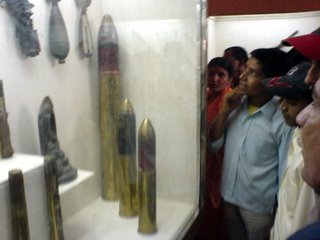
Aerial Bombs and Artillery used in the World War.
Army War Museum, Red Fort, Delhi, India
Army War Museum, Red Fort, Delhi, India
Pic taken by Freemind
Pic taken by Freemind
Situated on the Rajpath in New Delhi, India Gate (originally called the All India War Memorial) is a monument built by Edwin Lutyens to commemorate more than 90 000 Indian soldiers who died in the World War I and the Afghan Wars. The names of the soldiers who died in these wars are inscribed on the walls. Work on the monument started on 10 February 1921 and was completed in 1931.
Inscribed on top of India Gate in capital letters is the line:
To the dead of the Indian armies who fell honoured in France and Flanders Mesopotamia and Persia East Africa Gallipoli and elsewhere in the near and the far-east and in sacred memory also of those whose names are recorded and who fell in India or the north-west frontier and during the Third Afgan War.
To the dead of the Indian armies who fell honoured in France and Flanders Mesopotamia and Persia East Africa Gallipoli and elsewhere in the near and the far-east and in sacred memory also of those whose names are recorded and who fell in India or the north-west frontier and during the Third Afgan War.
Link: Pictures of Indian Soldiers in World War I
~~0~~
I am pasting the Times of India article below for your reading.
Sonia lays WWI Indian ghosts to rest
Rashmee Roshan Lall
10 Nov, 2006
Times News Network
YPRES (Belgium): On the 11th hour, of the 11th day (November 11) of the 11th month of the year 2006, Sonia Gandhi becomes the most senior Indian leader ever to lay to rest the ghosts of Indian soldiers who fought and fell here in World War I.
Eighty-eight years after the so-called Great War ended, leaving a variously estimated 43,000 to 65,000 Indians dead on the battlefield, Gandhi marks the ultimate sacrifice of the men who valiantly fought a white man's war, thousands of miles away from home, in a cause that was not their own.
Flying into Belgium on Friday, for a three-day visit, Gandhi's first scheduled official act is the trek to Ypres, the flat, battle-scarred wastelands in the west Flanders region, 130 km from Brussels.
At the Menin Gate, which is dedicated to soldiers with no known graves, Gandhi finally paid long-overdue tribute to India's heroic, generally-unheralded effort to help win Britain's war for the heart and soul of Europe.
In so doing, Gandhi redresses a famously perverse act of official Indian indifference.
Observers said it was especially poignant that Gandhi decided to visit Ypres and the Menin Gate, the route so many Indians and other British imperial army soldiers took towards the fighting, many never to return.
Observers said the chairwoman of the governing UPA coalition is the most senior Indian leader to pay tribute to India's WWI dead, most of whom were canon-fodder in line with Siegfried Sassaoon's famous lament in his poem, 'On Passing The Menin Gate': "Who will remember passing through this Gate / The unheroic Dead who fed the guns?"
Ypres, which has become legendary in literature and film as 'the Western Front', is littered with graves and headstones and its pockmarked earth blooms every year with blood-red wild poppies that have become a symbol of WWI savagery and suffering.
Every year, European and Commonwealth leaders, veterans and bereaved families gather here still to remember and vow never again to wage so brutal a war, but India officially pays little heed.
Now, Gandhi's visit changes all that.
Interestingly, in a sign that her government is intensely conscious about paying its debt to history, Gandhi's Ypres tribute comes nearly nine weeks after Pranab Mukherjee visited a memorial to the Indian dead at Neuve Chapelle, 300 km north of Paris, where the Indian Corps fought its first major battle in the Great War.
An estimated 1.3 million Indians served in WWI, with the men seeing extensive service on the Western Front; in the Battle of Gallipoli; in the Sinai, Palestine and Mesopotamia Campaigns; the Siege of Kut and in the Battle of Tanga in East Africa.
10 Nov, 2006
Times News Network
YPRES (Belgium): On the 11th hour, of the 11th day (November 11) of the 11th month of the year 2006, Sonia Gandhi becomes the most senior Indian leader ever to lay to rest the ghosts of Indian soldiers who fought and fell here in World War I.
Eighty-eight years after the so-called Great War ended, leaving a variously estimated 43,000 to 65,000 Indians dead on the battlefield, Gandhi marks the ultimate sacrifice of the men who valiantly fought a white man's war, thousands of miles away from home, in a cause that was not their own.
Flying into Belgium on Friday, for a three-day visit, Gandhi's first scheduled official act is the trek to Ypres, the flat, battle-scarred wastelands in the west Flanders region, 130 km from Brussels.
At the Menin Gate, which is dedicated to soldiers with no known graves, Gandhi finally paid long-overdue tribute to India's heroic, generally-unheralded effort to help win Britain's war for the heart and soul of Europe.
In so doing, Gandhi redresses a famously perverse act of official Indian indifference.
Observers said it was especially poignant that Gandhi decided to visit Ypres and the Menin Gate, the route so many Indians and other British imperial army soldiers took towards the fighting, many never to return.
Observers said the chairwoman of the governing UPA coalition is the most senior Indian leader to pay tribute to India's WWI dead, most of whom were canon-fodder in line with Siegfried Sassaoon's famous lament in his poem, 'On Passing The Menin Gate': "Who will remember passing through this Gate / The unheroic Dead who fed the guns?"
Ypres, which has become legendary in literature and film as 'the Western Front', is littered with graves and headstones and its pockmarked earth blooms every year with blood-red wild poppies that have become a symbol of WWI savagery and suffering.
Every year, European and Commonwealth leaders, veterans and bereaved families gather here still to remember and vow never again to wage so brutal a war, but India officially pays little heed.
Now, Gandhi's visit changes all that.
Interestingly, in a sign that her government is intensely conscious about paying its debt to history, Gandhi's Ypres tribute comes nearly nine weeks after Pranab Mukherjee visited a memorial to the Indian dead at Neuve Chapelle, 300 km north of Paris, where the Indian Corps fought its first major battle in the Great War.
An estimated 1.3 million Indians served in WWI, with the men seeing extensive service on the Western Front; in the Battle of Gallipoli; in the Sinai, Palestine and Mesopotamia Campaigns; the Siege of Kut and in the Battle of Tanga in East Africa.
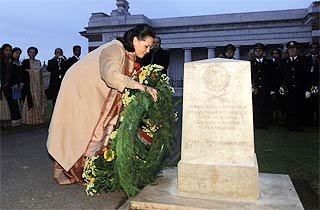 Sonia Gandhi pays tribute to Indian soldiers of World War I who sacrificed their lives in Ieper, Belgium. (AP)
Sonia Gandhi pays tribute to Indian soldiers of World War I who sacrificed their lives in Ieper, Belgium. (AP) 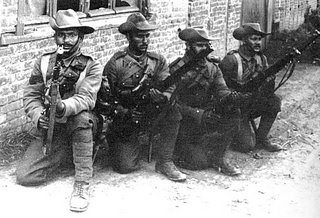
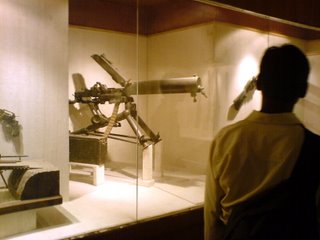
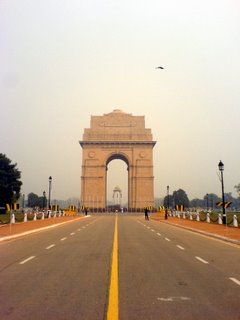




No comments:
Post a Comment